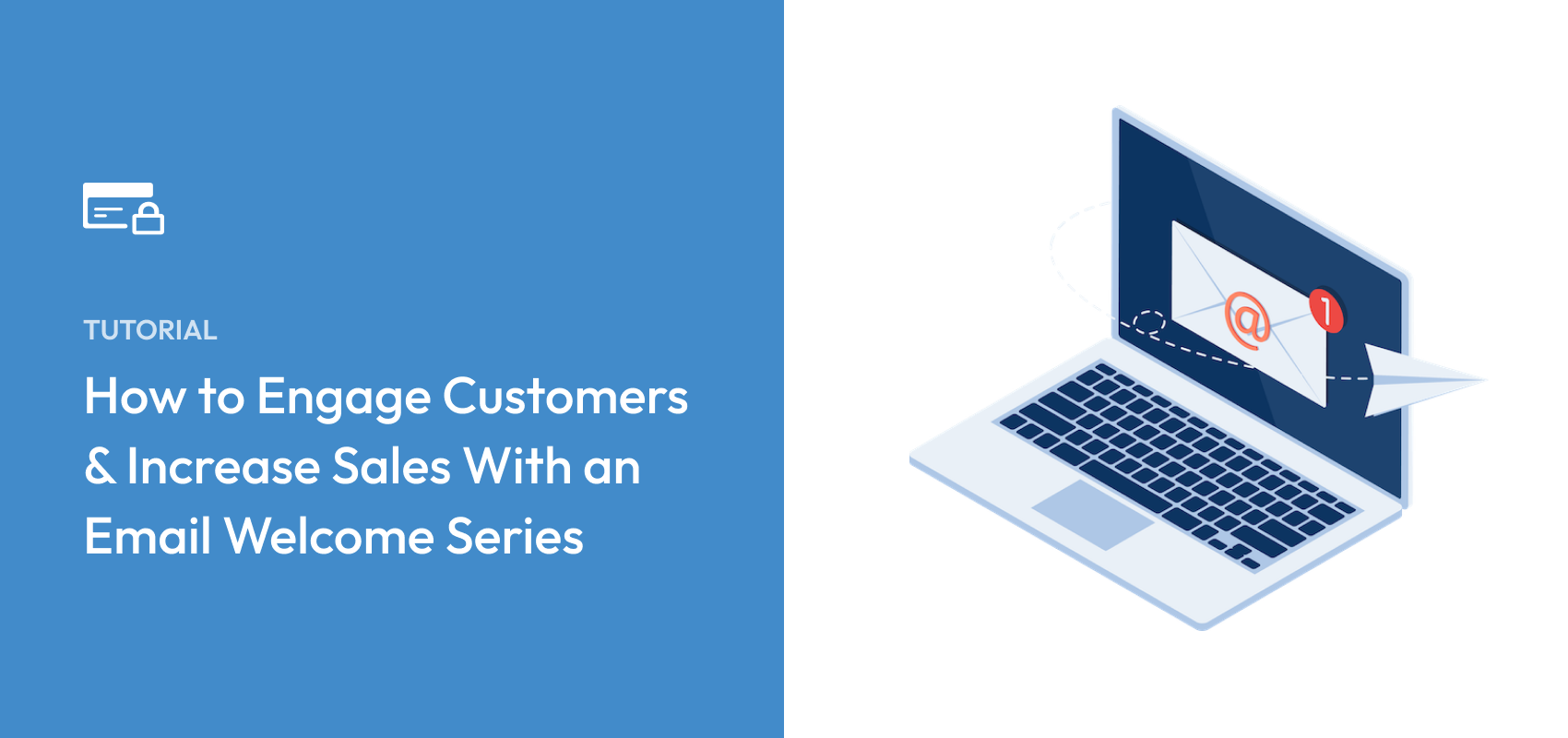How to Engage Customers & Increase Sales With an Email Welcome Series
Last updated on
Do you want to engage customers and subscribers with an email welcome series?
When new customers complete a purchase on your WordPress site, they’ll receive a payment confirmation email message. However, they won’t automatically receive an official welcome email introducing them to your brand or providing additional information about your products or services.
In this article, we’ll share what goes into an effective email welcome series and how to use it to improve customer engagement. We’ll also cover how you can increase sales by sending a welcome email series to those who have subscribed to your newsletter but haven’t made a purchase yet.
In This Article
What is an Email Welcome Series?
An email welcome series is a sequence of multiple emails you send to new customers. Typically, five to seven emails are in the sequence, with a delay of one or two days between each email.
The primary purpose of an email welcome series is to introduce new customers to your brand, provide them with critical information, and encourage them to take further steps while they’re motivated.
According to a recent study, the open rates for welcome emails are 4x higher than regular emails. In addition, welcome emails get 5x more clicks.
Here’s a simple example from Basic Piece. These emails arrive a couple of days apart after subscribing.
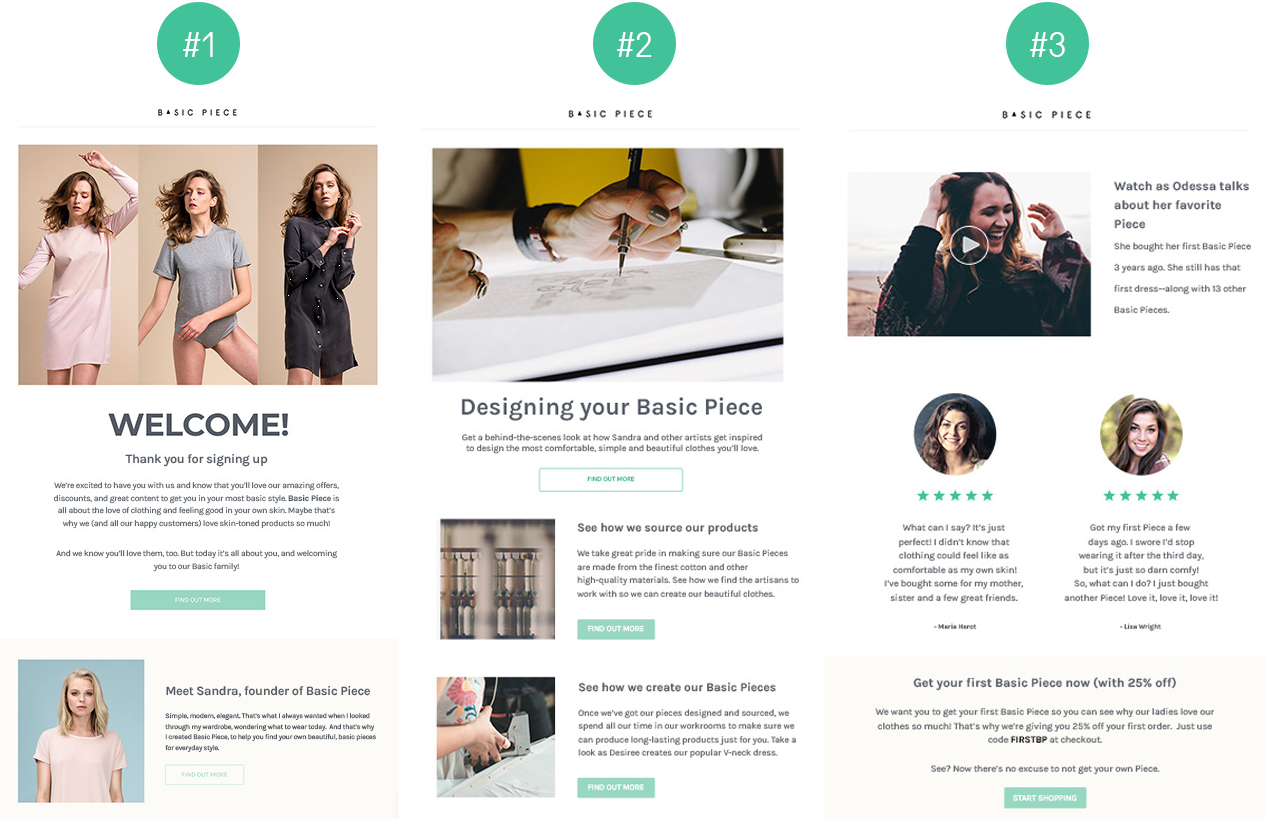
In email marketing software, the workflow looks something like this:
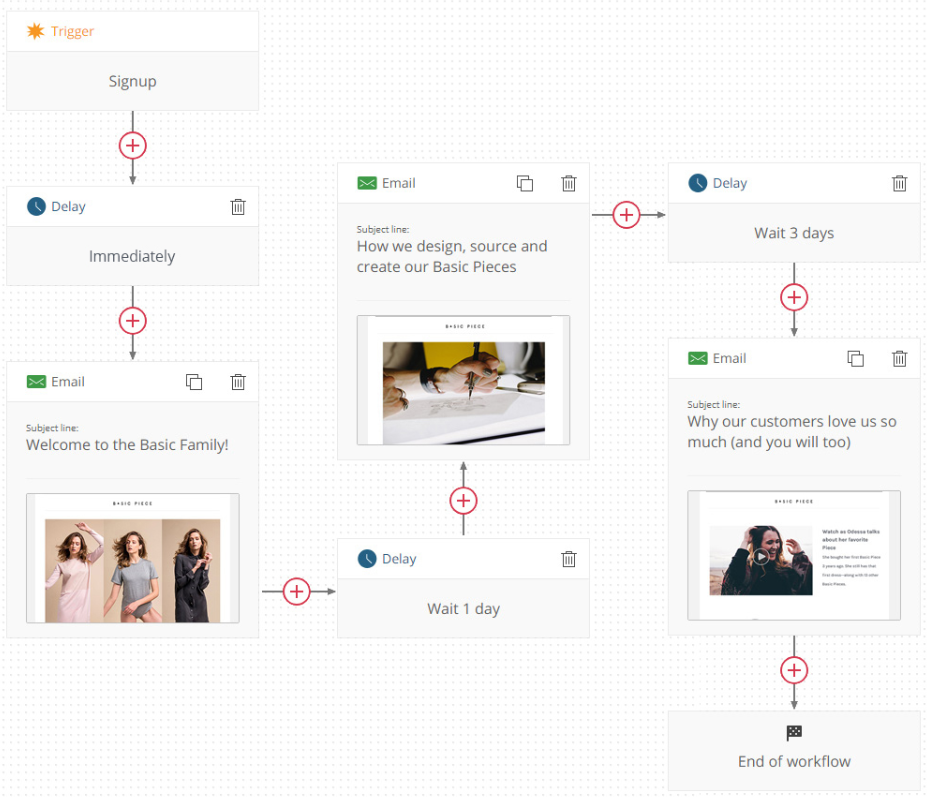
Think of it like this: Who is more likely to purchase? Someone who has been on your list for a while or someone who just joined?
Interestingly, it’s not a long-time subscriber. That person has already decided not to buy. Leads get colder by the day. They might be willing to buy in the future, but you’re more likely to sell to the new subscribers who are excited about your products.
You might be wondering, “Why don’t I just pile everything into a single email? Isn’t that simpler for everyone than creating a whole chain of emails?”
One email is a good start, but you don’t want to overwhelm your new subscribers. They may decide you aren’t worth the hassle and unsubscribe immediately. It’s better to deliver little nuggets of information over time so you don’t wear out your welcome.
Plus, a single email feels like a transaction. Multiple emails feel like a relationship.
Welcome Series Interval
For most welcome series sequences, sending one email each day or every other day is fine.
Don’t worry about over-sending right away. The beginning of your relationship with new subscribers is actually the best time to send email content more often than you normally would. After all, they just opted in to your list, so they’re ready to hear what you have to say.
Don’t allow too much time between emails. The recipient won’t see them as a connected series if you wait too long. You want them to think, “Oh, here’s the next email in that chain,” but not “Ugh, another one already.”
There are exceptions, of course. It’s important to consider your customers’ needs, preferences, and problems.
For example, if you kick off a welcome series by giving your recipients a free trial of your product, it’s smart to give them some time to actually use the product. One day may not be enough time for them to poke around, especially if it’s a work-related product and they signed up on a Sunday.
Sometimes, it makes sense to send more than one email per day. Home warranty companies are notorious for sending multiple emails the day a subscriber signs up. This is because the subscriber is often highly motivated to buy a warranty, and they’re simultaneously comparing multiple offers.
Welcome Series Content
Now that you understand why you should create an email welcome series, you’re probably wondering what to put in those emails. You have a lot of leeway here, but your goal is to build a stronger relationship with the recipient by adding value to their lives and enticing them to take action.
Ultimately, what you send depends on what you want your subscribers to know and do. Let’s go over some common options.
1. Deliver Something You Promised
Did you promise the subscriber a coupon, a free trial, or any other offer in exchange for their email address? Don’t pull tricks like, “We’ll send you that eBook soon, but first…” If you promised it, deliver it immediately.
2. Acknowledge Their Problems
At the beginning of your relationship with your subscribers, making them understand that you know their problems is important. They have to trust you as a problem solver, but they can’t until they know you get their problems.
3. Offer Tips and Best Practices
If your subscriber has already purchased or gained access to your product or services, use one or several of your welcome series emails to help them use it. This will increase the value they get from using your products or services.
Notice how this Airbnb welcome email tells the user how to get started with his or her account. It’s broken down nicely into three easy steps.
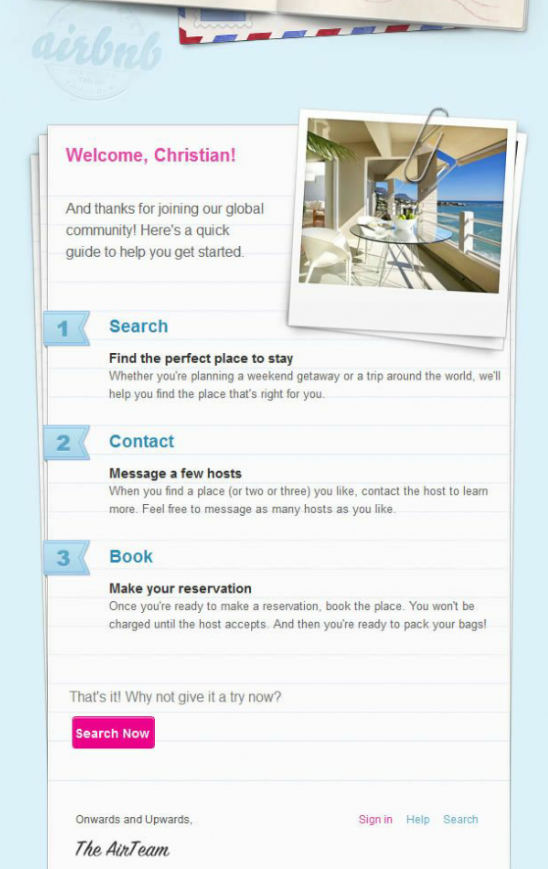
4. Introduce Products and Services
Of course, you want your emails to sell. If your subscribers haven’t made a purchase yet, the end of your welcome series is a good place to encourage them to buy.
If they have already made a purchase, use your welcome series to convince them to make additional purchases. You can include details about related products or perhaps products or services that have been recently updated.
5. Segment Your Email Subscribers
Email segmentation is the process of dividing and separating email subscribers into groups or segments based on criteria using tags and segments in your email marketing platform.
Segmenting your email lists is an important way to serve your email subscribers the content they love the most and avoid sending them irrelevant messages. But first, you have to learn about your subscribers so you know how to segment them.
This step is a lot easier than it sounds. There are two easy methods for dividing subscribers into segments.
First, you can simply ask your subscribers questions in the body of your first email. Make them all links attached to tags in your email automation software. Just ask them to click the links that apply to them.
For example, you could say, “Click the links that represent your interests,” with car, truck, and boat listed as choices. When they click a link, your email software will tag them appropriately so you can send them emails with related information in the future.
Alternatively, if you’re using WP Simple Pay, the #1 Stripe payments plugin for WordPress, to accept online payments, you can add extra fields to your payment form to learn more about your customers during the checkout process.
For example, you might add a field to your payment form that asks customers what they plan to do with your products or services. Depending on the answers you receive, you can funnel them into the appropriate segment to ensure they receive emails that help them reach their goals using your products.
WP Simple Pay lets you easily add custom fields to your payment forms using its advanced drag-and-drop form builder. The plugin offers dropdowns, text fields, and checkboxes.
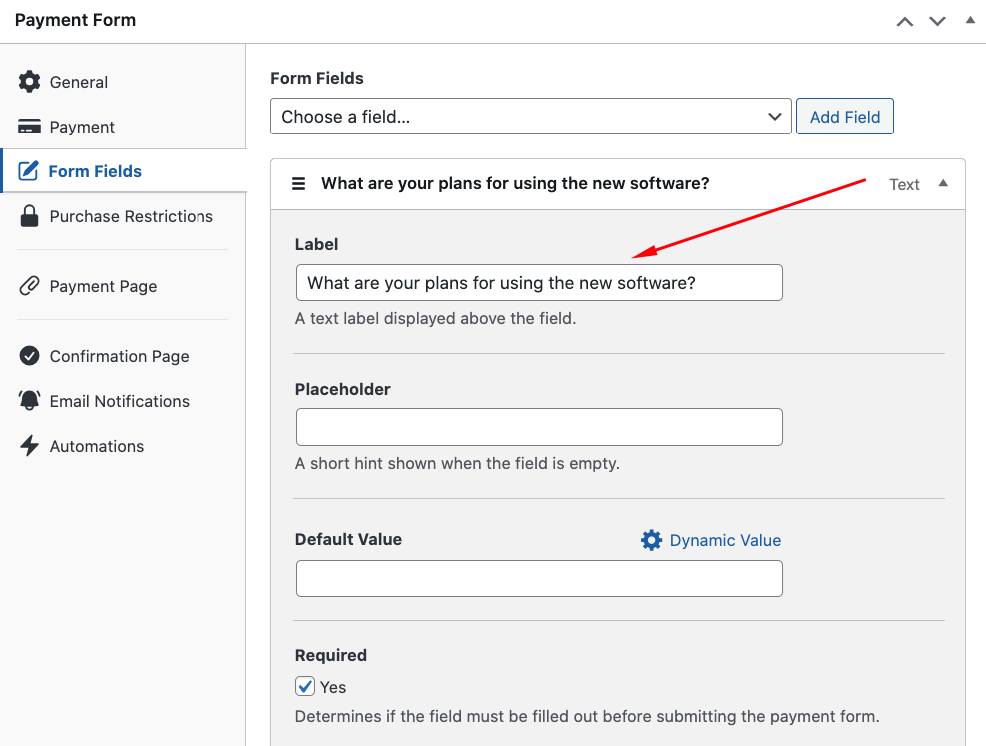
6. Create More Touchpoints
Do you have a Facebook page? A YouTube channel? Perhaps an Instagram, Twitter, or TikTok account?
If so, you’ll want your subscribers to follow you so you can connect with them more often. Be sure to mention those platforms throughout your welcome series.
7. Offer a Discount
If the subscriber hasn’t purchased yet, you may need to sweeten the deal with a discount. Sometimes, that’s all the customer needs to make a purchase. Just make sure to add an expiration date to your coupon to encourage them to act quickly.
WP Simple Pay lets you create custom coupon codes and add them to specific payment forms. You can also use the plugin to set up coupon redemption restrictions. If your business sells subscription-based products or services, offering a 100% discount on new subscription activations is easy with WP Simple Pay.
All you need to do to ensure that your subscribers receive the discount code is include it in your welcome email series.
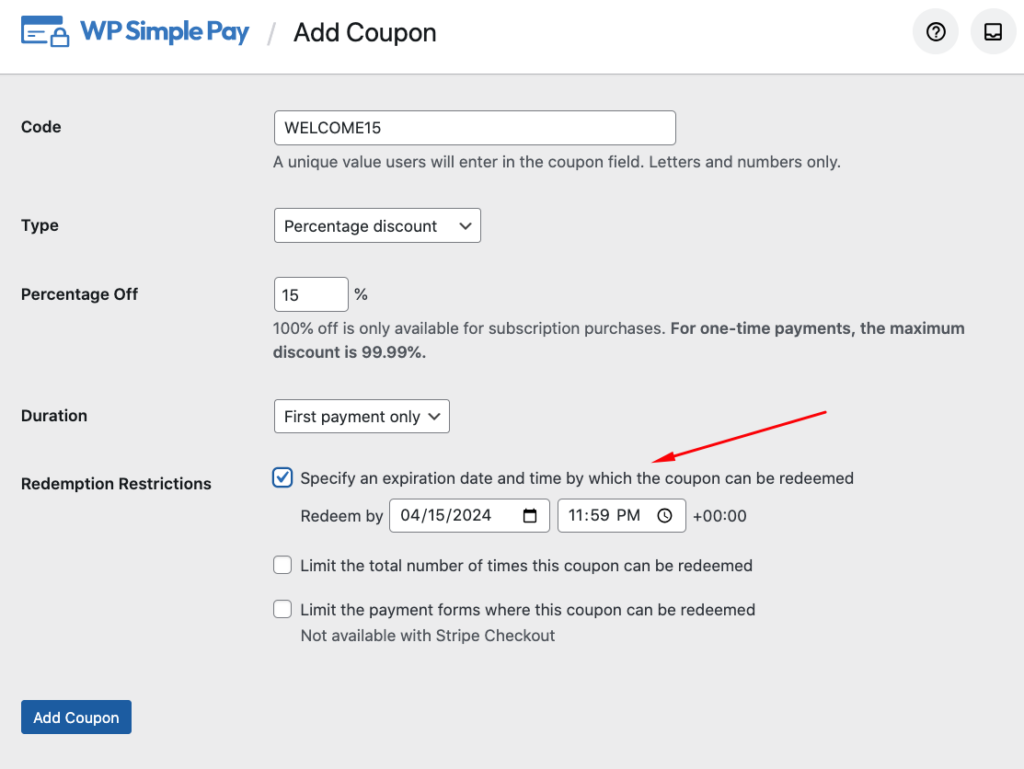
Michaels Craft Store knows its customers are bargain shoppers, so it isn’t afraid to lead its welcome series with a discount as a “thank you” for subscribing.
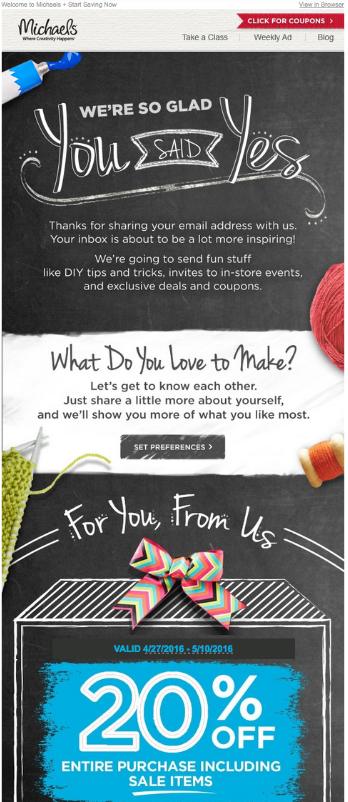
8. Ask for a Rating, Review, or Testimonial
Ratings, reviews, and testimonials are important for any business. Be sure to use an email in your welcome series to ask for feedback. You can simply send them to the right page to submit their review or have them reply to your email.
Welcome Series and Broadcasts
Like a lot of brands, you probably send broadcast emails. These are email blasts to everyone on your list (or in a segment). You write them as needed. They aren’t part of a sequence.
However, if you send a broadcast email to a subscriber who’s also receiving the welcome series at the same time, they could end up with a lot of emails in their inbox. This problem is compounded if they manage to get on other drip sequences at the same time.
Too many emails in a short period of time means your recipients will unsubscribe, even if those emails are otherwise valuable. No one wants to have an email inbox full of emails from you.
So, it’s important to configure your email marketing automation software carefully. Ensure anyone currently receiving a welcome series (or any sequence) is excluded from your broadcast emails.
To help determine which email marketing service provider is right for you, see our guide on the 7 Best Email Marketing Services for Small Businesses.
Keep in mind that Drip, a popular email marketing and automation platform, offers a pre-built template with workflow automation to help you create a welcome series.
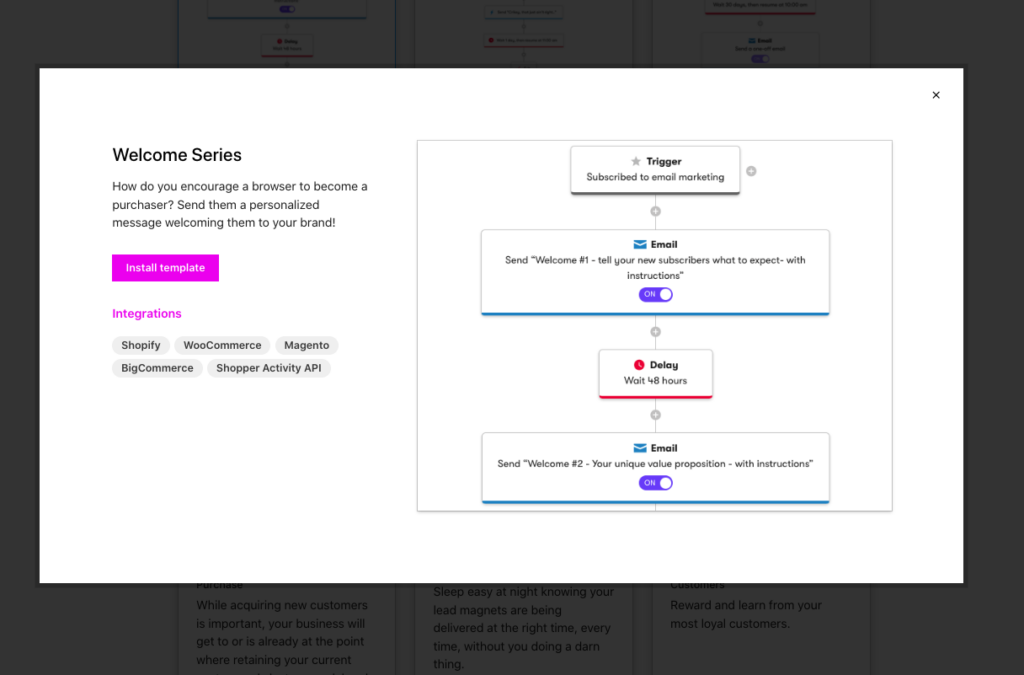
Measure Your Results
Unlike a broadcast email, your welcome series drips out over time. This means you can optimize it to improve its performance.
Be sure to use your email marketing automation software to track each email in your welcome series. Make tweaks to your subject lines and body content to get click-through and open rates as high as possible.
Email welcome sequences are key to engaging new customers and subscribers as well as building deeper relationships. Now that you understand how they work build yours as soon as you can. Optimize your email series over time. It won’t be long before you see higher engagement and, ultimately, more sales.
That’s it! We really hope this guide has helped you learn how to use an email welcome series to engage with your customers.
If you liked this article, you might also want to check out 6 tips for sending effective post-purchase emails.
What are you waiting for? Get started with WP Simple Pay today!
To read more articles like this, follow us on X.
Disclosure: Our content is reader-supported. This means if you click on some of our links, then we may earn a commission. We only recommend products that we believe will add value to our readers.
